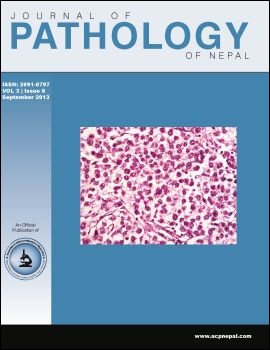Lymphoid associated antigen expression in new cases of Acute Myeloid Leukemia
DOI:
https://doi.org/10.3126/jpn.v3i6.8999Keywords:
Aberrant phenotype, AML, Lymphoid markerAbstract
Background: Occurrence of aberrant phenotype has been reported in acute leukemias with varying frequency though its prognostic importance remains controversial. In acute myeloid leukemias, aberrant phenotype, as high as 88 %, has been reported. To evaluate the occurrence of aberrant lymphoid phenotypes and to correlate their presence with various French American British classification, 100 cases of fresh acute myeloid leukemias were analyzed for lymphoid markers CD 4,7,8,10 and 19.
Materials and Methods: Whole blood or bone marrow aspirate collected in EDTA were processed by standard method and subjected to immunophenotyping for B Cells marker CD 19 and 10 and T cell marker CD 4, 7 and 8.
Results: Aberrant lymphoid markers were seen in 35(35%) cases. All FAB subtypes except M7 showed aberrancy for the markers studied. However it was the most common in M0 (100%), followed by M2 (51.9%). T cell aberrancy was the most common, comprising 62.8% (22/35) of total aberrancy. CD 7 was the most common aberrantly expressed marker, seen in 20% AML, followed by CD 4(14%) and CD 19 (8%).
Conclusion: Occurrence of lymphoid phenotypes is frequent in pediatric as well adult AML. Though T cell markers are more common, only B cell as well as both B and T cell markers may be co expressed.
DOI: http://dx.doi.org/10.3126/jpn.v3i6.8999
Journal of Pathology of Nepal (2013) Vol. 3, 487-490
Downloads
Downloads
Published
How to Cite
Issue
Section
License
This license enables reusers to distribute, remix, adapt, and build upon the material in any medium or format, so long as attribution is given to the creator. The license allows for commercial use.




